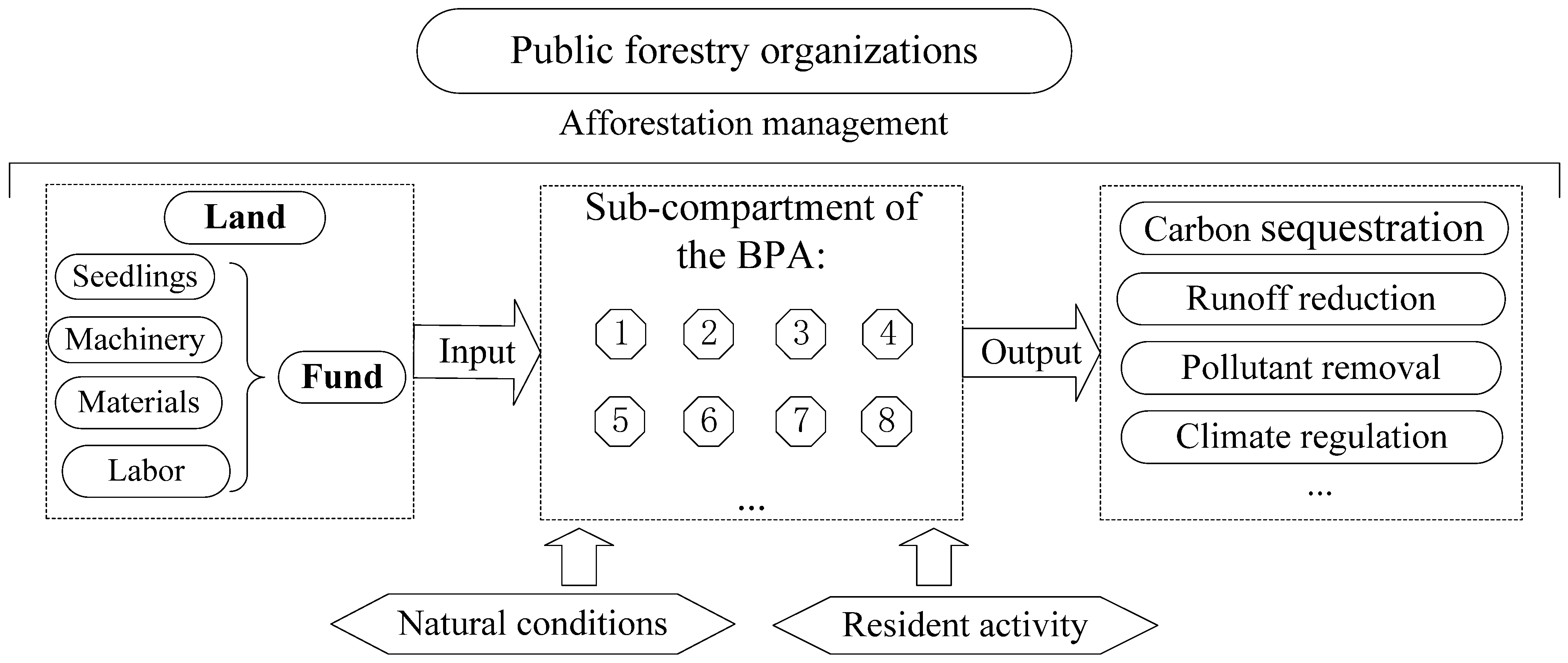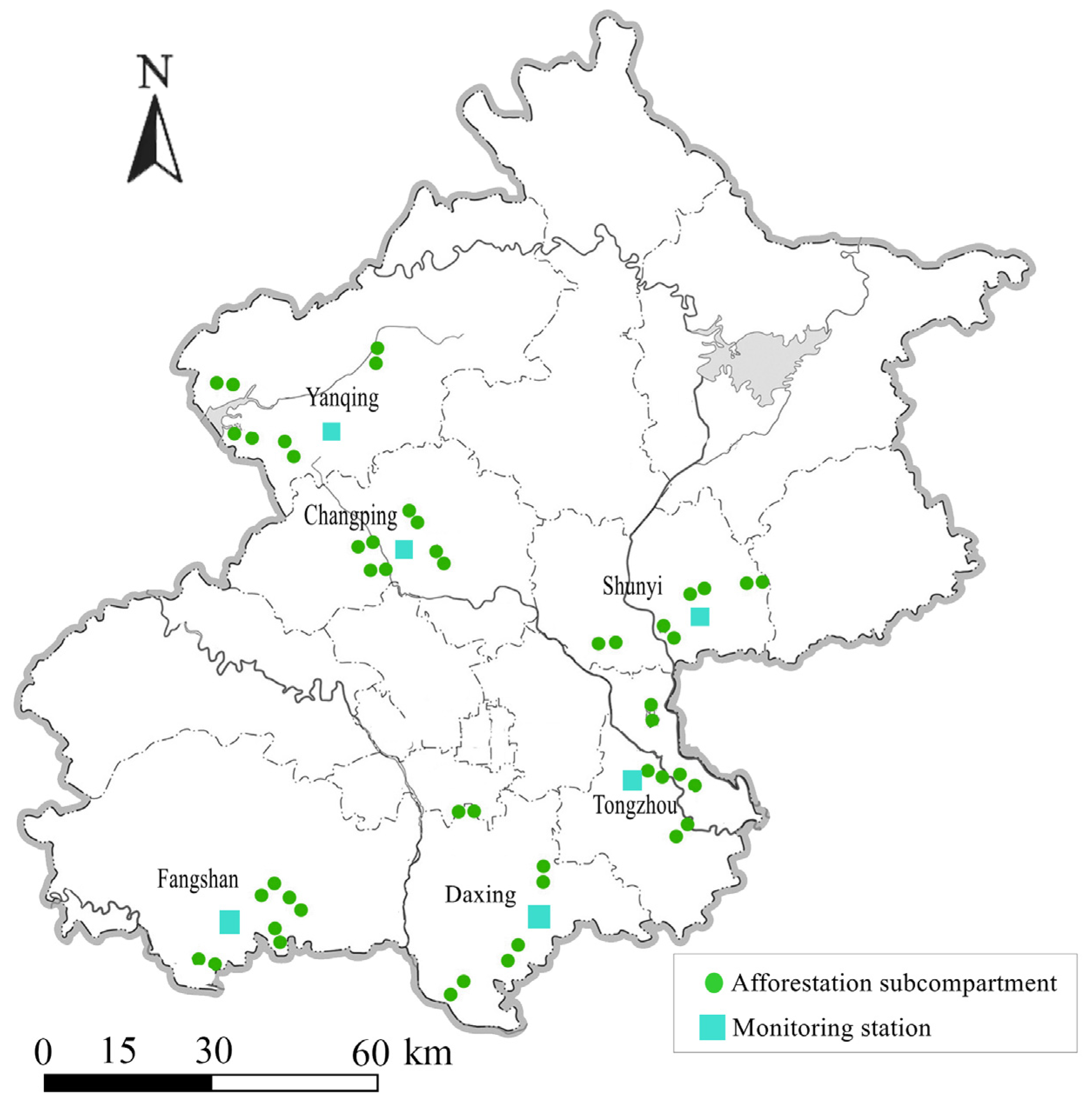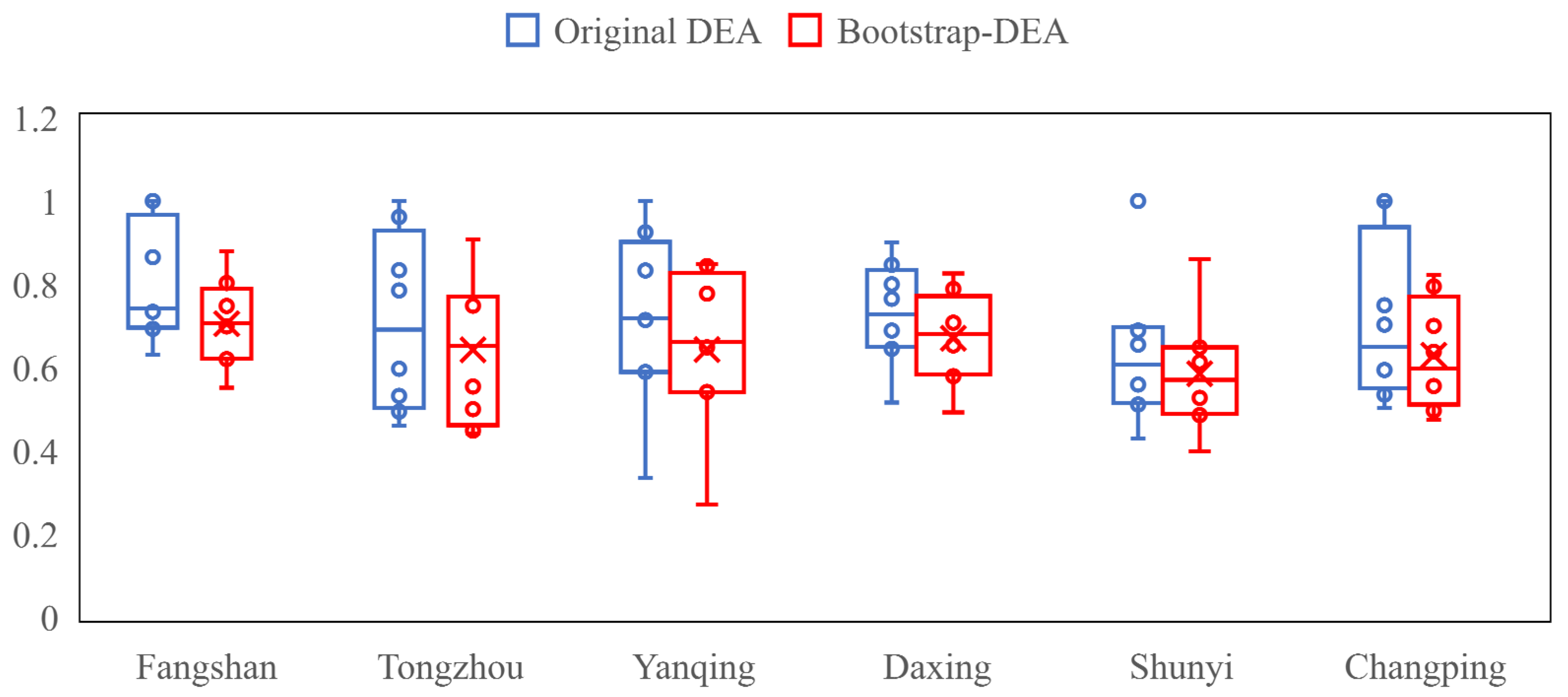Sustaining Urban Green Growth: Evaluating Ecological Efficiency and Resource-Use Drivers in Beijing’s Plains Afforestation Initiative
Abstract
1. Introduction
2. Materials and Methods
2.1. Analytical Framework
2.2. Methods
2.2.1. Bootstrap–DEA Model
- (1)
- Take the original input and output data as the initial sample of Bootstrap–DEA, and for each decision-making unit DMUk (k = 1, 2, …, n), calculate the efficiency scores using the DEA method.
- (2)
- Based on the efficiency score (k = 1, 2, …, n), a Naive Bootstrap sample of size n is drawn using the repeated sampling method, where b denotes the bth repeated sampling using the Bootstrap method.
- (3)
- The samples obtained from the plain Bootstrap are smoothed by using the kernel density estimation method to obtain and correct the input index (k = 1, …, n) of the original samples based on the Smoothing Bootstrap to obtain the adjusted (k = 1, …, n):Next, recalculate the efficiency scores using the DEA methodology based on the Bootstrap-adjusted input data and initial output data as a new sample:
- (4)
- Repeat steps (2) and (3) to obtain a series of efficiency scores and calculate the deviation of the corrected efficiency scores , the corrected efficiency scores , and their confidence intervals for each DMU (k = 1, …, n) with the following expressions:The confidence intervals for the level of the corrected DEA efficiency scores are:
2.2.2. Explaining Efficiency
2.3. Variable Definitions
2.4. Research Samples and Data
3. Results
3.1. Efficiency Analysis
3.2. Explaining the Differences in Efficiency
4. Discussion
5. Conclusions
Author Contributions
Funding
Institutional Review Board Statement
Informed Consent Statement
Data Availability Statement
Conflicts of Interest
References
- McPherson, E.G.; Simpson, J.R.; Xiao, Q.; Wu, C. Million trees Los Angeles canopy cover and benefit assessment. Landsc. Urban Plan. 2011, 99, 40–50. [Google Scholar] [CrossRef]
- Alberti, M.; Susskind, L. Managing urban sustainability: An introduction to the special issue. Environ. Impact Assess. Rev. 1996, 16, 213–221. [Google Scholar] [CrossRef]
- Escobedo, F.J.; Kroeger, T.; Wagner, J.E. Urban forests and pollution mitigation: Analyzing ecosystem services and disservices. Environ. Pollut. 2011, 159, 2078–2087. [Google Scholar] [CrossRef] [PubMed]
- Moffat, A.J. Communicating the benefits of urban trees: A critical review. Arboricult. J. 2016, 38, 64–82. [Google Scholar] [CrossRef]
- Pincetl, S. Implementing municipal tree planting: Los Angeles Million-Tree initiative. Environ. Manag. 2010, 45, 227–238. [Google Scholar] [CrossRef]
- Jones, B.A.; McDermott, S.M. The economics of urban afforestation: Insights from an integrated bioeconomic-health model. J. Environ. Econ. Manag. 2018, 89, 116–135. [Google Scholar] [CrossRef]
- Cao, H.; Yin, S.; Zhang, X.; Xiong, F.; Zhu, P.; Liu, C. Modeled PM2.5 removal by Urban Forest in Shanghai. J. Shanghai Jiaotong Univ. (Agric. Sci.) 2016, 34, 76–83. (In Chinese) [Google Scholar] [CrossRef]
- Wang, Y. Study on the promotion strategy of plain afforestation landscape in Daxing District from the perspective of landscape architecture. For. Resour. Manag. 2022, 6, 37–43. (In Chinese) [Google Scholar] [CrossRef]
- Chen, L.; Liu, C.; Pan, T.; Chen, C.; Li, Z.; Wang, H.; Pei, X.; Sun, L. Assessment of the effect of PM2.5 reduction by plain afforestation project in Beijing based on dry deposition model. Chin. J. Ecol. 2014, 33, 2897–2904. (In Chinese) [Google Scholar] [CrossRef]
- Yu, H. Carbon accounting for afforestation project in the pain area of Beijing: A case study of Eastern Suburb Forest Park, Beijing. Ecol. Econ. 2022, 38, 110–115. (In Chinese) [Google Scholar]
- Lü, Y.; Wang, Y.; Zheng, X. Influence of forest landscape pattern on flood mitigation in Beijing Plain based on SWAT model. Acta Ecol. Sin. 2021, 41, 4036–4051. (In Chinese) [Google Scholar] [CrossRef]
- Yu, Z.; Liu, X.; Zhang, J.; Xu, D.; Cao, S. Evaluating the net value of ecosystem services to support ecological engineering: Framework and a case study of the Beijing Plains afforestation project. Ecol. Eng. 2018, 112, 148–152. [Google Scholar] [CrossRef]
- Sunderland, T.; Rogers, K.; Coish, N. What proportion of the costs of urban trees can be justified by the carbon sequestration and air-quality benefits they provide? Arboric. J. 2012, 34, 62–82. [Google Scholar] [CrossRef]
- Xue, X.; Zhao, J.; Shi, M.; Wei, S.; Wu, M. Ecological benefit evaluation of street trees in Zhengzhou City based on i-Tree model. Henan Sci. 2018, 36, 1460–1467. (In Chinese) [Google Scholar]
- Liao, W.; Tong, T.; Qin, K.; Gao, X. Efficiency theory, measurement and factors influencing input-output of forest land in China: Summary and prospect. J. Agro For. Econ. Manag. 2018, 17, 545–552. (In Chinese) [Google Scholar] [CrossRef]
- Li, C.; Li, N.; Luo, H.; Wang, B. The efficiency analysis and path optimization of forestry input-output in China based on Data Envelopment Analysis. Chin. Agric. Sci. Bull. 2011, 27, 55–59. (In Chinese) [Google Scholar]
- Huang, A.; Liu, Z.; Xu, J.; Lin, Q.; Lan, Y.; Su, S.; Zhang, C. Forestry total factor productivity under multiple targets in China and its spatiotemporal differences. Sci. Silvae Sin. 2015, 51, 117–125. (In Chinese) [Google Scholar]
- Viitala, E.J.; Hänninen, H. Measuring the efficiency of public forestry organizations. For. Sci. 1998, 44, 298–307. [Google Scholar] [CrossRef]
- Ma, D.; Wang, X. Comparative analysis of management efficiency of family forestry farms in Gansu Province. Issues For. Econ. 2020, 40, 45–52. (In Chinese) [Google Scholar]
- Wei, J.; Zhang, L. Analysis of forestry input-output efficiency in Guangxi based on DEA method. J. Cent. S. Univ. For. Technol. (Soc. Sci.) 2016, 10, 55–60. (In Chinese) [Google Scholar]
- Liu, Y.; Yang, Z.; Xu, G.; Yang, Q.; Liu, S.; He, K. Correlation between ecosystem services value and human activity intensity based on the four-quadrant model: A case study in the International Tourism and Culture Demonstration Area, the South Anhui Province. Acta Ecol. Sin. 2022, 42, 5200–5210. (In Chinese) [Google Scholar] [CrossRef]
- Xu, L.; Gao, G.; Wang, X.; Chen, Y.; Zhou, C.; Wang, K.; Fu, B. Quantifying the contributions of climate change and human activities to vegetation greening in the drylands of northern China. Acta Ecol. Sin. 2023, 43, 7274–7283. (In Chinese) [Google Scholar] [CrossRef]
- Banker, R.D.; Charnes, A.; Cooper, W.W. Some models for estimating technical and scale inefficiencies in Data Envelopment Analysis. Manag. Sci. 1984, 30, 1078–1092. [Google Scholar] [CrossRef]
- Simar, L.; Wilson, P.W. Sensitivity analysis of efficiency scores: How to Bootstrap in Nonparametric Frontier Models. Manag. Sci. 1998, 44, 49–61. [Google Scholar] [CrossRef]
- Hu, Z.; He, X.; Li, Y.; Zhu, J.; Li, X. Human activity intensity and its distribution pattern of Minjiang River. Chin. J. Ecol. 2007, 26, 539–543. (In Chinese) [Google Scholar]
- Wang, R.; Xin, X.; Pei, S.; Guo, J.; Wu, D. Sulfur dioxide absorption and accumulation capacity of 9 common urban greening tree species in Beijing. For. Res. 2017, 30, 392–398. (In Chinese) [Google Scholar] [CrossRef]
- Chang, C.; Wang, S. Effects of rainfall interception and runoff reduction by urban canopy based on i-Tree Eco model. J. Arid. Land Resour. Environ. 2021, 35, 136–142. (In Chinese) [Google Scholar] [CrossRef]
- Dong, X.; Chen, C.; Li, H.; Xie, N.; Zhao, Y.; Fang, K. Effects on Illumination on growth of Pinus densiflora. Prot. For. Sci. Technol. 2018, 172, 36–40. (In Chinese) [Google Scholar] [CrossRef]
- Vaughn, R.M.; Hostetler, M.; Escobedo, F.J.; Jones, P. The influence of subdivision design and conservation of open space on carbon storage and sequestration. Landsc. Urban Plan. 2014, 131, 64–73. [Google Scholar] [CrossRef]
- Xie, X.Y.; Cui, Y.J.; Qiu, E.F.; Fu, Q.C. Analysis on changes of street tree structure in Beijing from 2010 to 2020. J. Beijing For. Univ. 2023, 45, 78–88. [Google Scholar] [CrossRef]
- Li, L. Environmental goods provision and gentrification: Evidence from Million Trees NYC. J. Environ. Econ. Manag. 2018, 120, 102828. [Google Scholar] [CrossRef]
- Blanchette, A.; Lang, C.; VanCeylon, J. Variation in Valuation: Open Space and Geography. Land Econ. 2021, 97, 768–780. [Google Scholar] [CrossRef]
- Black, K.J. Wide open spaces: Estimating the willingness to pay for adjacent preserved open space. Reg. Sci. Urban Econ. 2018, 71, 110–121. [Google Scholar] [CrossRef]
- Lang, C. Assessing the efficiency of local open space provision. J. Public Econ. 2018, 158, 12–24. [Google Scholar] [CrossRef]




| Variable Type | Variables | Variable Interpretation |
|---|---|---|
| Input variable | Afforestation area | Sub-compartment area (hm2) |
| Total expenses | Total sub-compartment expenses (yuan) | |
| Output variable | Carbon sequestration | Sub-compartment carbon sequestration (t) |
| Runoff reduction | Sub-compartment runoff reduction (m3) | |
| Pollutant removal | Total air pollutants removed from the sub-compartment (t) | |
| Climate regulation | Sub-compartment trees absorb heat by transpiration in summer (J) | |
| Interpretation variable | Air quality | Air quality index (AQI) around the sub-compartment |
| Annual precipitation | Sub-compartment annual precipitation (mm) | |
| Sunshine hours | Sub-compartment sunshine hours (h) | |
| Human activity intensity | Human activity intensity (HAI) around the sub-compartment | |
| Afforestation density | Sub-compartment afforestation density | |
| Number of tree species | Number of tree species in the sub-compartment | |
| Proportion of native tree species | Proportion of native tree species in the sub-compartment | |
| Maintenance standard | Sub-compartment maintenance standard | |
| Proportion of local subsidies | Proportion of local subsidies in total expenditure for the sub-compartment |
| Carbon Sequestration | Runoff Reduction | Pollutant Removal | Climate Regulation | |
|---|---|---|---|---|
| Afforestation area | 0.787 *** | 0.675 *** | 0.772 *** | 0.826 *** |
| Total expenses | 0.633 *** | 0.657 *** | 0.889 *** | 0.873 *** |
| Original DEA Results | Bootstrap–DEA Results | |
|---|---|---|
| Mean comprehensive efficiency score | 0.715 | 0.646 |
| Mean pure technical efficiency score | 0.752 | 0.664 |
| Mean scale efficiency score | 0.950 | 0.973 |
| Maximum comprehensive efficiency score | 1 | 0.901 |
| Minimum comprehensive efficiency score | 0.335 | 0.271 |
| Number of efficient DMUs | 7 | 0 |
| Interpreted Variable | Coef. | Std. Err. | t-Value |
|---|---|---|---|
| lnAD | −0.208 | 0.105 | −1.51 |
| PNT | 0.091 ** | 0.064 | 2.40 |
| NTS | −0.130 | 0.077 | −0.34 |
| MS | 0.212 *** | 0.039 | 4.17 |
| PLS | 0.435 ** | 0.164 | 2.65 |
| DH | 0.001 | 0.001 | 0.64 |
| AQI | 0.002 | 0.002 | 0.89 |
| AP | −0.001 | 0.001 | −1.00 |
| HAI | 0.151 | 0.164 | 0.88 |
| _cons | −0.586 | 0.848 | −0.69 |
| LR chi2 (9) | 30.31 | Prob > chi2 | 0.000 |
Disclaimer/Publisher’s Note: The statements, opinions and data contained in all publications are solely those of the individual author(s) and contributor(s) and not of MDPI and/or the editor(s). MDPI and/or the editor(s) disclaim responsibility for any injury to people or property resulting from any ideas, methods, instructions or products referred to in the content. |
© 2025 by the authors. Licensee MDPI, Basel, Switzerland. This article is an open access article distributed under the terms and conditions of the Creative Commons Attribution (CC BY) license (https://creativecommons.org/licenses/by/4.0/).
Share and Cite
Wu, Y.; Jiang, J.; Chen, B. Sustaining Urban Green Growth: Evaluating Ecological Efficiency and Resource-Use Drivers in Beijing’s Plains Afforestation Initiative. Sustainability 2025, 17, 2722. https://doi.org/10.3390/su17062722
Wu Y, Jiang J, Chen B. Sustaining Urban Green Growth: Evaluating Ecological Efficiency and Resource-Use Drivers in Beijing’s Plains Afforestation Initiative. Sustainability. 2025; 17(6):2722. https://doi.org/10.3390/su17062722
Chicago/Turabian StyleWu, Yuanhao, Jun Jiang, and Beibei Chen. 2025. "Sustaining Urban Green Growth: Evaluating Ecological Efficiency and Resource-Use Drivers in Beijing’s Plains Afforestation Initiative" Sustainability 17, no. 6: 2722. https://doi.org/10.3390/su17062722
APA StyleWu, Y., Jiang, J., & Chen, B. (2025). Sustaining Urban Green Growth: Evaluating Ecological Efficiency and Resource-Use Drivers in Beijing’s Plains Afforestation Initiative. Sustainability, 17(6), 2722. https://doi.org/10.3390/su17062722






